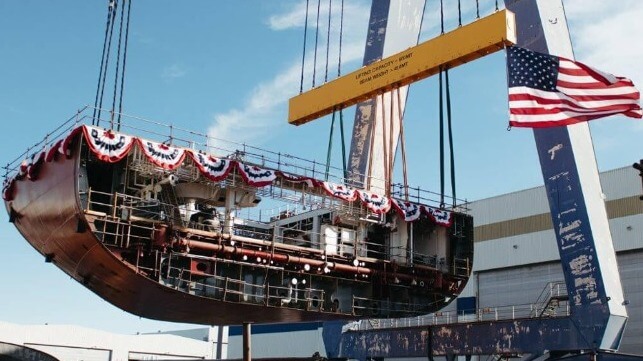Keel is Laid for Massachusetts Maritime’s New Training Ship

The keel block for the second of five new purpose-built, state-of-the-art training vessels for America’s state maritime academies was set into place today at the Philly Shipyard marking the next milestone in the project. The start of the assembly of the second vessel, which will be named Patriot State, comes just days after the first vessel, Empire State VII, left the dry dock for her final stage of outfitting.
Work on the second of the vessels began in March 2021 with the first steel cut. Today’s keel laying was a ceremonial recognition in which the first grand block of the vessel is loaded into the building dock. The second NSMV (National Security Multi-Mission Vessel) is scheduled to be delivered to Massachusetts Maritime Academy in 2024.
“The keel laying ceremony is an event that never gets old, and this one was especially meaningful, given the future intended use of the Patriot State,” said Rear Admiral Francis X. McDonald, President of the Massachusetts Maritime Academy. “The NSMVs are historic for all the state maritime academies and will offer needed training platforms for the next generation of mariners, as well as serve as essential support vessels in times of disaster or distress. We are honored that the Massachusetts Maritime Academy has been designated as the recipient of this vessel, and are incredibly grateful for the commitment it shows to our future mariners.”
The program to replace the aging training vessels at the state-operated maritime schools officially began in May 2019 when MARAD selected TOTE Services to be the vessel construction manager for the NSMV program. TOTE is overseeing the construction of the five vessels which will all be built at Philly Shipyard. These ships, which will be owned by MARAD, represent the first time the United States has built training vessels for the merchant marine. The ships are being assigned to the schools in New York, Massachusetts, Maine, Texas, and California.
The NSMV is an investment both in America’s shipbuilding industry, which supports nearly 400,000 jobs, and the future of the merchant marine. Each NSMV will feature numerous instructional spaces, a full training bridge, and accommodations for up to 600 cadets to train in an academic environment at sea. The state maritime academies graduate more than half of all new officers each year employed both in the merchant marine and also supporting U.S. national security by crewing military sealift vessels.
Historically the academies have been assigned older, surplus vessels after their active commercial lives. In addition to lacking dedicated training facilities, the vessels have older, dated equipment and technology and now face challenges with the pending environmental regulations.
Mass Maritime currently employs a vintage 1960s break bulk cargo C4 type freighter built by Avondale Industries in New Orleans, Louisiana. The vessel was delivered as the Velma Lykes and entered service in 1967 operating on routes to the Far East. She was retired and placed in the Ready Reserve Fleet in 1985 and after service during Dessert Storm Gulf War in 1991 was converted into a training ship in 2003 named TS Enterprise. In 2009, she was further overhauled and renamed TS Kennedy.
The last of a dying breed, the Kenney is a 540-foot steamship. The new Patriot State will measure 525 feet in length with an 89-foot beam. Each of the new training vessels is designed with a sailing range of more than 10,000 miles at 18 knots. Each vessel has bow and stern thrusters and a modern diesel power plan that includes four engines split between two engine rooms. In addition to the training bridge, they also have a cargo crane and ramp for ro-ro operations.
The TS Kennedy was used in 2012 by FEMA as part of the relief operation after Superstorm Sandy devastated parts of New York and New Jersey and again in 2017 for relief to Puerto Rico after Hurricane Maria. The new training vessels were designed to operate similar humanitarian relief missions.
